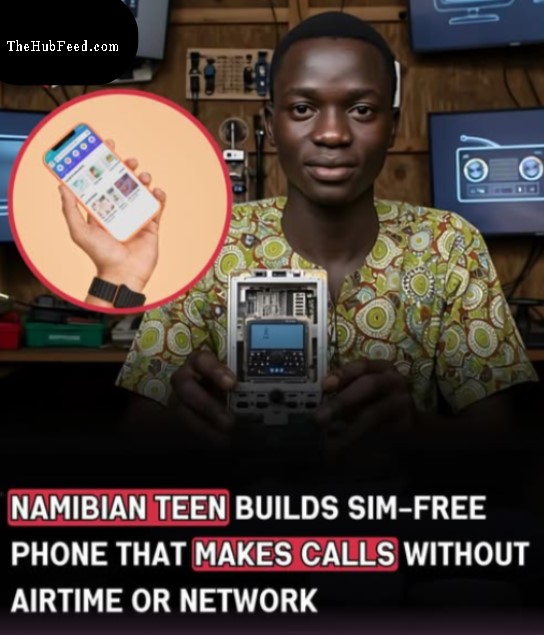Namibian Teenager Develops SIM-Free Phone That Makes Calls Without Network Connection
In a groundbreaking innovation, a Namibian teenager has made waves in the tech world by creating a SIM-free phone capable of making calls without the need for airtime or a network connection. This cutting-edge device uses a unique technology that bypasses traditional communication systems, offering a game-changing solution for areas with limited or no network coverage. The invention has the potential to revolutionize global communication, especially in remote and underserved locations where connectivity has long been a challenge.
A Solution to the Connectivity Problem
For many people living in rural or remote areas, access to reliable communication networks is a constant issue. Traditional mobile phones rely on SIM cards, network towers, and airtime to connect users, leaving those in areas without strong coverage or infrastructure disconnected. This innovative phone, developed by the teenage inventor, provides an alternative that could dramatically improve access to communication in places where other forms of connectivity are unavailable.

Using a combination of innovative technology and creative problem-solving, the teenager’s invention has managed to bypass the need for conventional network connections, enabling users to make calls even in locations with no cellular network or internet access. This breakthrough could be transformative, especially in rural communities or emergency situations where conventional communication methods are not an option.
How the Device Works
While the exact technical details behind the phone’s operation remain closely guarded by the inventor, the key feature of this device lies in its ability to transmit and receive calls without relying on traditional SIM cards or network infrastructure. By utilizing a combination of short-range communication protocols, the phone can connect to other nearby devices or local communication hubs that facilitate voice communication.
This system allows the phone to function even when there is no access to the usual mobile towers or satellite coverage. As a result, the device has the potential to be a lifeline for individuals in remote locations or developing regions, offering a simple yet effective means of staying in touch with others.
A Leap Towards Global Connectivity
This innovation represents a significant step forward in addressing one of the most pressing challenges in global communications: the lack of network coverage in rural and underserved areas. Millions of people around the world still live in regions with minimal access to mobile networks, meaning they are left without the ability to make calls, access the internet, or stay connected with the outside world.
By developing a SIM-free phone that can work without airtime or traditional network infrastructure, the Namibian teenager has brought attention to a critical issue—one that has implications not just for individuals, but for the entire global tech industry. This device could serve as an essential tool for humanitarian efforts, emergency response teams, and individuals living in areas with little to no access to mobile or internet networks.
The Power of Creativity and Problem-Solving
This remarkable achievement highlights the importance of creativity, innovation, and determination in addressing global challenges. The teenager’s ability to identify a real-world problem and develop a technological solution demonstrates how young minds can drive positive change, particularly in fields such as science and technology.
In a world where technology often feels overwhelming and complicated, this invention serves as a reminder that sometimes the best solutions are the simplest ones. By thinking outside the box and leveraging existing technologies in new ways, this young inventor has created something that could have a lasting impact on global communication, bringing people closer together despite geographic or infrastructure barriers.
A Step Closer to Bridging the Digital Divide
This invention is a major step toward bridging the digital divide that exists between different regions of the world. In many remote areas, the lack of network coverage is a barrier to education, healthcare, and economic opportunities. The ability to communicate without reliance on traditional networks could empower individuals to connect with the outside world, access essential information, and even pursue new opportunities, all of which can significantly improve their quality of life.
Moreover, this invention sets an example for young innovators and aspiring engineers worldwide. It demonstrates that innovation doesn’t always have to come from large corporations or established institutions. Sometimes, the most powerful solutions come from individuals who are simply passionate about solving problems and making a difference.
The Future of Communication
While this SIM-free phone is still in its early stages, the potential applications are vast. As technology continues to evolve, it is likely that similar devices could become even more efficient, offering a seamless communication experience even in the most remote areas. This invention paves the way for more research and development in communication technologies that can help bridge the gap between urban and rural, connected and disconnected regions of the world.
In a time when access to communication is crucial, innovations like this could be key in creating a more connected, inclusive, and equitable world. By leveraging technology to solve real-world problems, we are one step closer to ensuring that no one is left behind when it comes to staying connected.
This young Namibian inventor’s breakthrough not only challenges the status quo of global communications but also proves that with a little creativity and determination, we can overcome even the most daunting technological barriers.
